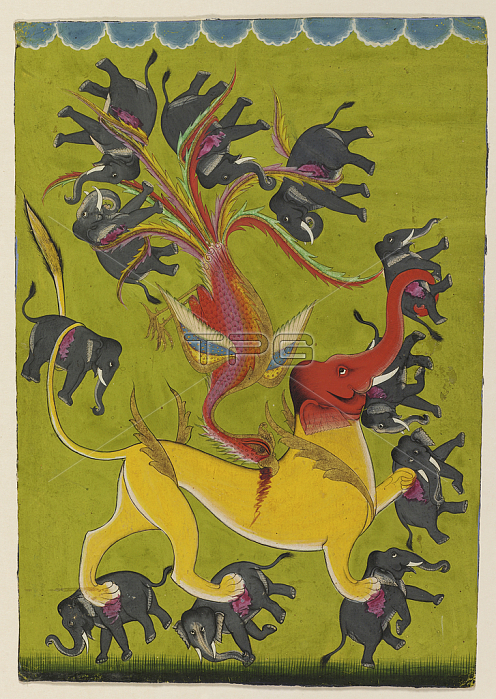
450964 Simurgh Attacking a Gaja-Simha Carrying Elephants, early 19th century (opaque w/c & gold on paper) by Indian School, (19th century); 32.1 x 22.9 cm; Philadelphia Museum of Art, Pennsylvania, PA, USA; (add.info.: Made in Jodhpur, Rajasthan, India. With the yellow body of a lion, four golden wings, and a bright red elephant\'s head, the Gaja-Simha (Elephant-Lion) flings seven small elephants around using claws, trunk, tusks, and tail. Swooping down on him is a fabulously colored bird, the Simurgh, which upends four more elephants in her tail feathers. It is a bloody battle-the Simurgh\'s beak sinks deep into the Gaja-Simha\'s back, and each of the elephants is wounded where the larger beasts grasp them. In Islam, the Simurgh represents union with the divine. The motif was brought from Persia to India, where it may have merged with the sunbird Garuda, vahana (vehicle) of the god Vishnu. The motif of a Simurgh attacking a Gaja-Simha carrying elephants appears in Mughal art in India as early as 1600.); 穢 Philadelphia Museum of Art ; Stella Kramrisch Collection, 1994; Indian, out of copyright.
| px | px | dpi | = | cm | x | cm | = | MB |
Details
Creative#:
TOP27068438
Source:
達志影像
Authorization Type:
RM
Release Information:
須由TPG 完整授權
Model Release:
No
Property Release:
No
Right to Privacy:
No
Same folder images:

 Loading
Loading